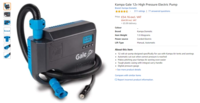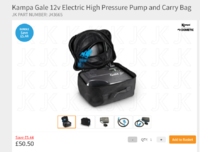Angela
Member
Heya all, I’m just calling out for some info and to let you know our woes.
We brought a Vango airhub hexaway from the camping and caravan show 2 years ago and off we go all excited to use it and that September we come to find it leaked not just a little basically a river running down the innards of the unit soaking everything in its path. We were a little annoyed but thought maybe an accident the factory and it missed the waterproofing stage, so hey ho, emails were sent. Vango collected it and took it away kept it for a couple of months then one day out of the blue a new one arrives at our door, no note, no apology, but once again as we are the chillest people in the universe think yay a new unit, September here we come.
You’d think this is where the drama ends but sadly noooooo.
We put it up this year and have it up for 7 whole nights and the thing explodes like a cannon going off bringing half a campsite running over to our pitch to see we now own a hub hexaway with no air. The explosion so bad it didn’t just blow the plastic spider unit it blew and tore out the material going down the tent.
I don’t know about anyone else but the chillest people in the universe are now a tad fed up with Vango. One holiday I’d not say ruined but not enjoyed fully sitting with umbrellas inside the air hub, the second holiday again hampered but this time costly as we had to run out to Argos and buy two throw out pop up tents as we needed storage for all our belongings, there wasn’t a better tent unit for 90 miles due to low stock this year.
Has anyone else had similar experiences or are we just the unluckiest people in the Vango world. We are now in communications with the people who sold it as obviously right now we would like a refund or a credit note but I think the idea is going to be again Vango collect it and keep it for a couple of months then send us another new unit. If this is the case we will soon be having a brand new air hub up for sale as I honestly can’t face schlepping another on of those things to Devon to pitch it to not use it.
We brought a Vango airhub hexaway from the camping and caravan show 2 years ago and off we go all excited to use it and that September we come to find it leaked not just a little basically a river running down the innards of the unit soaking everything in its path. We were a little annoyed but thought maybe an accident the factory and it missed the waterproofing stage, so hey ho, emails were sent. Vango collected it and took it away kept it for a couple of months then one day out of the blue a new one arrives at our door, no note, no apology, but once again as we are the chillest people in the universe think yay a new unit, September here we come.
You’d think this is where the drama ends but sadly noooooo.
We put it up this year and have it up for 7 whole nights and the thing explodes like a cannon going off bringing half a campsite running over to our pitch to see we now own a hub hexaway with no air. The explosion so bad it didn’t just blow the plastic spider unit it blew and tore out the material going down the tent.
I don’t know about anyone else but the chillest people in the universe are now a tad fed up with Vango. One holiday I’d not say ruined but not enjoyed fully sitting with umbrellas inside the air hub, the second holiday again hampered but this time costly as we had to run out to Argos and buy two throw out pop up tents as we needed storage for all our belongings, there wasn’t a better tent unit for 90 miles due to low stock this year.
Has anyone else had similar experiences or are we just the unluckiest people in the Vango world. We are now in communications with the people who sold it as obviously right now we would like a refund or a credit note but I think the idea is going to be again Vango collect it and keep it for a couple of months then send us another new unit. If this is the case we will soon be having a brand new air hub up for sale as I honestly can’t face schlepping another on of those things to Devon to pitch it to not use it.





